Tim Hecker | ||
| Allmusic Biography : Montreal producer Tim Hecker made his initial breakthrough with experimental techno and IDM as Jetone but followed it with ambient music attributed to his real name. This experimental ambient work, released by the Alien8 sublabel Substractif beginning in late 2001 with Haunt Me Haunt Me, Do It Again, won much acclaim. It also familiarized listeners with the producer himself, and not just because it featured his real name rather than a moniker: Heckers self-titled work was much more personal than his Jetone recordings, its ideological characteristics reflecting his interests and its experimental slant reflecting his ambitions. For his self-titled recordings, Hecker drew inspiration from pop culture and showcased his ideas within dense collages of found sounds and computer-generated noise. Critics loved the experimentation and also the ideological richness, as exemplified by conceptual albums such as 2011s Ravedeath, 1972 and 2016s Love Streams. It also didnt hurt, of course, that Heckers more techno-oriented work as Jetone attracted a large following of curious listeners who otherwise probably wouldnt seek out such ambient music. The producer also extensively performed live, another means of connecting with his continually growing audience. As a graduate student studying digital acoustics and software, Hecker spent years dabbling with electronic music before finally debuting as Jetone in 2000 with Autumnumonia for Pitchcadet. The release interested Force Inc., which released Heckers next album as Jetone, Ultramarin, a year later. Following this popular release, he aligned himself with Alien8, an experimental label based in Montreal. He recorded Haunt Me Haunt Me, Do It Again for Alien8s sublabel Substractif, and watched it inspire critical praise upon its release in late 2001. The album proved so successful that Substractif released a follow-up EP, the Van Halen-themed My Love Is Rotten to the Core, less than a year later in hopes of building upon the lingering critical buzz surrounding Haunt Me. Hecker then recorded Radio Amor for Mille Plateaux, which released the album in April 2003. Inspired by a 1996 journey to Central America, where he experienced a memorable boat ride off the coast of Honduras, Radio Amor consolidated the various aspects of Heckers previous two efforts into his most accessible ambient work to date, and accordingly won him yet more acclaim. In 2004, Mirages came out, followed by his contribution to Staalplaats Mort aux Vaches series, a 41-minute live radio set that was released in 2005. The next year, Heckers first album for Kranky, Harmony in Ultraviolet, hit shelves. In 2007, Hecker released the 20-minute CD single Norberg on the Australian label Room40 and 10" EP Atlas on Audraglint Recordings. The 2008 Alien8 release Fantasma Parastasie was a collaboration with Nadjas Aidan Baker, and it was followed by An Imaginary Country, another solo full-length on Kranky. In 2010, Hecker issued the 7" single "Apondalifa" on Room40. The solo album Ravedeath, 1972 was released in 2011. The ambitious work was themed around the destruction of music, and included contributions from Ben Frost. The album was enormously well-received, garnering acclaim from numerous publications and often being referred to as Heckers best work to date. Later that year, Hecker released Dropped Pianos, a darker-hued companion piece to Ravedeath. In 2012, he collaborated with Oneohtrix Point Nevers Daniel Lopatin on Instrumental Tourist, which featured jazz-inspired improvisations from both producers. The album was the first in a series of collaborations to appear on Software, the label Lopatin ran with another frequent collaborator, Joel Ford. October 2013 saw the Kranky release of Virgins, a deliberate excursion into live, improvisatory performance recorded in Montreal, Reykjavik, and Seattle with an ensemble of musicians playing woodwinds, piano, and synths. Hecker contributed the song "Amps, Drugs, Mellotron" to Adult Swims 2014 summer singles series. In 2015, Room40 released Norberg/Apondalifa, an LP containing both previous single releases. The following year, Hecker made his debut on 4AD with Love Streams, which featured vocals by the Icelandic Choir Ensemble with arrangements scored by Jóhann Jóhannsson. Heckers follow-up appeared in 2018, and his ninth record also marked a return to Kranky. Konoyo was inspired by gagaku, a type of Japanese classical music performed at the Imperial Court in Kyoto, and featured the gagaku ensemble Tokyo Gakuso. Companion album Anoyo, recorded during the same sessions as Konoyo, was released in 2019. | ||
 | Album: 1 of 18 Title: Haunt Me, Haunt Me Do It Again Released: 2001-11-20 Tracks: 20 Duration: 53:57 Scroll: Up Down Top Bottom 25% 50% 75% Allmusic AlbumCover | 1 Music for Tundra, Part 1 (05:13) 2 Music for Tundra, Part 2 (01:57) 3 Music for Tundra, Part 3 (00:39) 4 Arctic Lovers Rock, Part 1 (05:34) 5 Arctic Lovers Rock, Part 2 (00:56) 6 The Work of Art in the Age of Cultural Overproduction (07:35) 7 October, Part 1 (03:35) 8 October, Part 2 (01:08) 9 Ghost Writing, Part 1 (04:29) 10 Ghost Writing, Part 2 (01:20) 11 City in Flames (In Three Parts), Part 1 (02:58) 12 City in Flames (In Three Parts), Part 2 (02:46) 13 City in Flames (In Three Parts), Part 3 (00:54) 14 Border Lines, Part 1 (04:56) 15 Border Lines, Part 2 (00:21) 16 Boreal Kiss, Part 1 (03:28) 17 Boreal Kiss, Part 2 (00:32) 18 Boreal Kiss, Part 3 (01:59) 19 Night Flight to Your Heart, Part 1 (02:28) 20 Night Flight to Your Heart, Part 2 (01:03) |
| Haunt Me, Haunt Me Do It Again : Allmusic album Review : On Haunt Me Haunt Me, Do It Again, Tim Hecker downshifts from his minimal techno alias, Jetone, to create rich, textured ambient music of the highest order. Despite the infusion of glitch elements like static and electronic interference, Haunt Me Haunt Me, Do It Again sounds deep and wide, like it was meant to bounce around a cathedral, or as an accompaniment to a planetarium show. There are nine titled pieces here spread across 20 tracks and one bleeds into the next, lending an unusual sense of continuity for an experimental electronic release of this length. Glistening drones are threaded with deliberate hiss and ghostly voices and the occasional treated piano and percussive elements crop up here and there as accents. While the tracks vary in approach and character, the overall mood is consistently one of contemplation, wonder, and awe, with vague hints of dread and violence appearing in the periphery. Picking out individual highlights is difficult because the album is so consistent, unified, and whole; suffice to say that Haunt Me Haunt Me, Do It Again is a brilliant album of subtle, evocative mood music. | ||
 | Album: 2 of 18 Title: My Love Is Rotten to the Core Released: 2002-06-25 Tracks: 5 Duration: 24:49 Scroll: Up Down Top Bottom 25% 50% 75% Spotify AlbumCover | 1 Introducing Carl Cocks (08:31) 2 Sammy Loves Eddie Hates David (02:50) 3 Hello Detroit (07:24) 4 Midnight Whispers (00:59) 5 The Return of Sam Snead (05:03) |
 | Album: 3 of 18 Title: Radio Amor Released: 2003-03-25 Tracks: 10 Duration: 58:20 Scroll: Up Down Top Bottom 25% 50% 75% Spotify Allmusic AlbumCover | 1 Song of the Highwire Shrimper (07:24) 2 (They Call Me) Jimmy (04:52) 3 Spectral (08:09) 4 Im Transmitting Tonight (05:16) 5 7000 Miles (05:43) 6 Shipyards of La Ceiba (01:56) 7 Careless Whispers (05:11) 8 The Star Compass (04:49) 9 Azure Azure (10:34) 10 Trade Winds, White Heat (04:22) |
| Radio Amor : Allmusic album Review : Tim Heckers first album for Mille Plateaux, Radio Amor, follows two excellent efforts for the relatively smaller yet similarly prestigious Substractif label, and accordingly consolidates that pair into his most inclusive and presentable recording yet. It merges the haunting majesty of his debut full-length, Haunt Me Haunt Me, Do It Again (2001), with the loose conceptual framework of his follow-up EP, My Love Is Rotten to the Core (2002), and does so without being quite as overbearing as those two releases may have felt to listeners interested in simply engaging music rather than far-fetched conception. There are thus two primary sides to Radio Amor: its sounds and concepts. The sonic palette Hecker draws from here is strikingly reminiscent of his previous work. Heavily manipulated waves of drone again clash and splash against one another, often doing so with near yet subtly off synchronicity in the right and left channels. The effect is slightly disorienting, and thats precisely the point, as Heckers overall aesthetic seems centered upon an otherworldly style of sound manipulation meant to baffle even the most seasoned digital-music listeners. The conceptual framework he builds upon is likewise hazily vague, and no doubt purposefully so. The track titles dont allude to much on their own, yet when coupled with the albums remarkable packaging, a whispered narrative begins to shape, one involving remote seafaring, faint transmissions, compass guidance, and a third-world locale. Its perhaps fitting then that the albums climax, its most deliciously harrowing seasick moment, "Azure Azure," comes late in the album, following "The Star Compass" and preceding "Trade Winds, White Heat." By that point, Hecker has once again swept you away with a seamless album that demands beginning-to-end listening, and this time he does so with the timeless grandeur and universal appeal of a Hemingway-esque lost-at-sea novel narrated from the omniscient perspective. This is far, far from your ordinary ambient album -- if youre willing to dive into its depth rather than merely skim its surface, that is. | ||
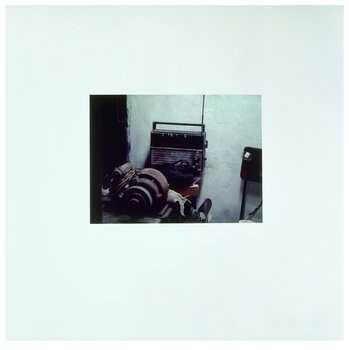 | Album: 4 of 18 Title: Radio Marti / Radio Havana Released: 2004 Tracks: 2 Duration: 24:44 Scroll: Up Down Top Bottom 25% 50% 75% AlbumCover | 1 Radio Marti (11:10) 2 Radio Havana (13:34) |
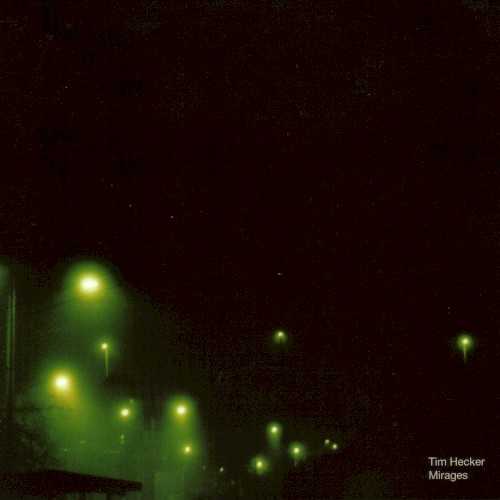 | Album: 5 of 18 Title: Mirages Released: 2004-09-20 Tracks: 11 Duration: 47:39 Scroll: Up Down Top Bottom 25% 50% 75% Spotify Allmusic AlbumCover | 1 Acéphale (04:57) 2 Neither More nor Less (03:10) 3 Aerial Silver (03:37) 4 Celestina (04:31) 5 Counter Attack (02:13) 6 The Truth of Accountants (02:21) 7 Aerial Light-Pollution Orange (03:09) 8 Non Mollare (01:10) 9 Kaito (03:08) 10 Balkanize-You (08:37) 11 Incurably Optimistic! (10:40) |
| Mirages : Allmusic album Review : At the height of their powers, white-noise godheads My Bloody Valentine would be known to leave their guitars alone on-stage at the end of a performance, feeding back for up to 30 minutes while the audience was left awash in the sound of static running on static. Imagining that effect not as an end, but as a beginning, Canadian Tim Hecker offers his third album of dark grey fog (his sixth album if you count his techno background as Jetone). Starting with "Acephale," Hecker takes control of the effluvial hiss and slowly melts it down, making it into clear angelic tones on "Neither More Nor Less," fluttering waves on "Celestina," and even rounded pulses on "Kaito." But like a gentle master, Hecker eventually breaks his smoke bubbles, allowing the gas to float free on the generously long closer, "Incurably Optimistic!" Yet low and behold, the vapors continue to hold the shapes in which they were once held, drifting not up and away, but moving in paths around an undeterminable axis until they finally disappear without the least bit of a whimper. But like matter, sound is a finite yet never depleting thing, transferring from electrical buzz to moving air to cerebral stimulation. Potential energy waiting, just waiting to go kinetic again. | ||
 | Album: 6 of 18 Title: Mort Aux Vaches Released: 2004-10-03 Tracks: 1 Duration: 40:43 Scroll: Up Down Top Bottom 25% 50% 75% Spotify Allmusic Wikipedia AlbumCover | 1 Mort Aux Vaches (40:43) |
| Mort Aux Vaches : Allmusic album Review : Tim Hecker fans, beware: his contribution to Staaplaats Mort aux Vaches series is significantly quieter than his previous opuses. That being said, it is also one of his sleekest releases. His live set for the Dutch national radio VPRO consists of a continuous 41-minute piece. Early on, he strikes a delightful balance between tone and texture, pairing quiet electrical noise with a delicate string chord (lifted from some Mahler, perhaps?). That figure will become the leitmotif of the piece: individual tones or chords barely surfacing from a quiet storm of noise. Grace and seduction soak the piece, along with a sense of well-being in a society where interference has become the main ground rule. Voices are occasionally heard, their discourse no more than a murmur, their tone just another surfacing note. The piece evolves very slowly during the first 20 minutes, delicately shifting between textural layers. At the 20-minute mark the piece collapses inward and falls nearly silent. The second half is characterized by a quiet noise foundation spiced up by musical events -- a proto-melody here, a pretty music box-like development there, a quick surge in volume to introduce a new element that will gradually disappear the moment you detect its presence. The whole piece carries the listener like a daydream, careful not to jolt him/her out of his/her reverie, yet skillful enough to feed the dream through its whole duration. As is the case with all Mort aux Vaches releases, this album is in a limited edition of 1,000 copies. | ||
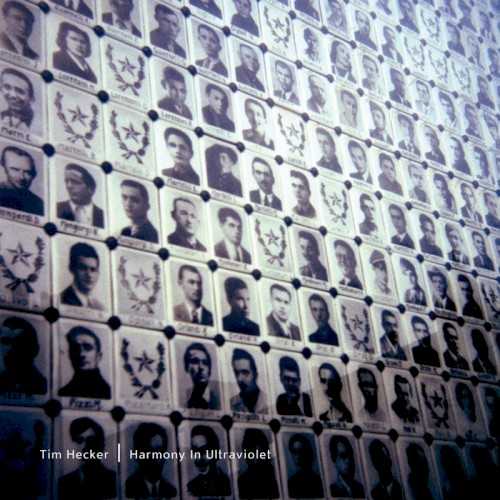 | Album: 7 of 18 Title: Harmony in Ultraviolet Released: 2006-10-16 Tracks: 15 Duration: 50:00 Scroll: Up Down Top Bottom 25% 50% 75% Spotify Allmusic AlbumCover | 1 Rainbow Blood (01:52) 2 Stags, Aircraft, Kings and Secretaries (04:30) 3 Palimpsest I (00:35) 4 Chimeras (03:13) 5 Dungeoneering (05:24) 6 Palimpsest II (00:38) 7 Spring Heeled Jack Flies Tonight (03:11) 8 Harmony in Blue I (01:31) 9 Harmony in Blue II (01:52) 10 Harmony in Blue III (02:41) 11 Harmony in Blue IV (02:02) 12 Radio Spiricom (04:52) 13 Whitecaps of White Noise I (07:29) 14 Whitecaps of White Noise II (05:57) 15 Blood Rainbow (04:06) |
| Harmony in Ultraviolet : Allmusic album Review : Canadian Tim Hecker has been a respected force on the electronica scene since his debut Haunt Me Haunt Me, Do It Again, came out in 2001 (in addition to his work as Jetone). Since then, he has consistently released experimental ambient music that broadens standard compositional barriers while still remaining accessible, and such is the case with Harmony in Ultraviolet, Heckers fourth full-length. Though most of the tracks on the album are separate entities -- including each part of "Harmony in Blue" -- they work together to form an idea thats greater than its individual elements: a sense of exploration and sadness and understanding of the infiniteness and uncertainty and expanse of the world. Themes are introduced -- a looped arpeggio, a distorted guitar riff, lone keyboard notes -- but nothing is ever fully developed, nothing ever completely exposes itself. Instead, theres a suggestion thats built-up and expounded upon but never quite resolved, long notes that pull themselves in and out of focus are favored over melodies, leaving a kind of agitation in the listener like the dark restlessness of an industrial city. Three notes make a chord but somehow Heckers dont, theyre so different in texture and scope; in fact, they seem almost peacefully at odds with one another, aware of the others existences but content to ignore them. Its the music of a gray urban skyline, of the kind of loneliness that comes from being around too many other people, of rusted fences and cold empty windows and distance, music that swells and crescendos, sets itself up for the denouement but never arrives at the climax; its endlessly patient yet eager to move on. Wet bass notes and emaciated electric guitars, awash with distortion, crush together with programmed noise and drones, sounds erupt and are then dismissed, fifty minutes of questions and intimations, of resignation and acceptance, but not -- definitely not -- of answers. Well have to find those ourselves. | ||
 | Album: 8 of 18 Title: Norberg Released: 2007 Tracks: 1 Duration: 20:25 Scroll: Up Down Top Bottom 25% 50% 75% Spotify AlbumCover | 1 Norberg (20:25) |
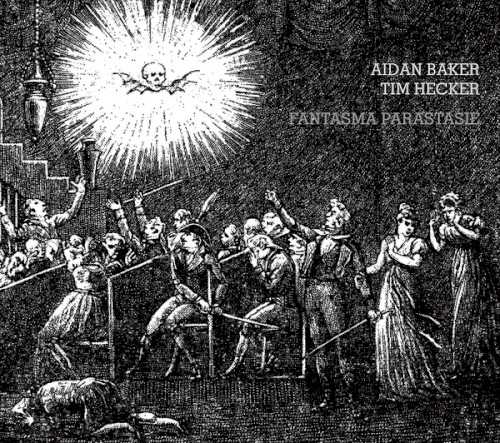 | Album: 9 of 18 Title: Fantasma Parastasie Released: 2008-10-14 Tracks: 66 Duration: 34:24 Scroll: Up Down Top Bottom 25% 50% 75% Allmusic AlbumCover | 1 Phantom on a Pedestal, Part 1 (00:15) 2 Phantom on a Pedestal, Part 2 (00:44) 3 Phantom on a Pedestal, Part 3 (00:29) 4 Phantom on a Pedestal, Part 4 (01:20) 5 Phantom on a Pedestal, Part 5 (00:20) 6 Phantom on a Pedestal, Part 6 (00:32) 7 Phantom on a Pedestal, Part 7 (00:44) 8 Phantom on a Pedestal, Part 8 (00:29) 9 Phantom on a Pedestal, Part 9 (00:26) 10 Phantom on a Pedestal, Part 10 (00:26) 11 Hymn to the Idea of Night, Part 1 (00:23) 12 Hymn to the Idea of Night, Part 2 (00:29) 13 Hymn to the Idea of Night, Part 3 (00:41) 14 Hymn to the Idea of Night, Part 4 (00:29) 15 Hymn to the Idea of Night, Part 5 (00:46) 16 Hymn to the Idea of Night, Part 6 (00:40) 17 Hymn to the Idea of Night, Part 7 (00:28) 18 Hymn to the Idea of Night, Part 8 (00:25) 19 Hymn to the Idea of Night, Part 9 (00:11) 20 Hymn to the Idea of Night, Part 10 (00:14) 21 Hymn to the Idea of Night, Part 11 (00:28) 22 Auditory Spirits, Part 1 (00:27) 23 Auditory Spirits, Part 2 (00:14) 24 Auditory Spirits, Part 3 (00:16) 25 Auditory Spirits, Part 4 (00:16) 26 Auditory Spirits, Part 5 (00:17) 27 Auditory Spirits, Part 6 (00:26) 28 Auditory Spirits, Part 7 (00:28) 29 Auditory Spirits, Part 8 (00:16) 30 Auditory Spirits, Part 9 (00:32) 31 Auditory Spirits, Part 10 (00:12) 32 Auditory Spirits, Part 11 (00:14) 33 Skeleton Dance, Part 1 (00:18) 34 Skeleton Dance, Part 2 (00:14) 35 Skeleton Dance, Part 3 (00:23) 36 Skeleton Dance, Part 4 (00:16) 37 Skeleton Dance, Part 5 (00:20) 38 Skeleton Dance, Part 6 (00:17) 39 Skeleton Dance, Part 7 (00:13) 40 Skeleton Dance, Part 8 (00:11) 41 Skeleton Dance, Part 9 (00:13) 42 Skeleton Dance, Part 10 (00:13) 43 Skeleton Dance, Part 11 (00:17) 44 Gallery of the Invisible Woman, Part 1 (00:08) 45 Gallery of the Invisible Woman, Part 2 (00:11) 46 Gallery of the Invisible Woman, Part 3 (00:20) 47 Gallery of the Invisible Woman, Part 4 (00:10) 48 Gallery of the Invisible Woman, Part 5 (00:17) 49 Gallery of the Invisible Woman, Part 6 (00:21) 50 Gallery of the Invisible Woman, Part 7 (00:31) 51 Gallery of the Invisible Woman, Part 8 (00:41) 52 Gallery of the Invisible Woman, Part 9 (00:33) 53 Gallery of the Invisible Woman, Part 10 (00:56) 54 Gallery of the Invisible Woman, Part 11 (03:04) 55 Dream the Nightmare, Part 1 (00:25) 56 Dream the Nightmare, Part 2 (00:15) 57 Dream the Nightmare, Part 3 (00:17) 58 Dream the Nightmare, Part 4 (00:41) 59 Dream the Nightmare, Part 5 (00:44) 60 Dream the Nightmare, Part 6 (00:09) 61 Dream the Nightmare, Part 7 (00:28) 62 Dream the Nightmare, Part 8 (00:16) 63 Dream the Nightmare, Part 9 (00:15) 64 Dream the Nightmare, Part 10 (00:31) 65 Dream the Nightmare, Part 11 (00:13) 66 Fantasma-Parastasie (04:50) |
 | Album: 10 of 18 Title: An Imaginary Country Released: 2009-03-09 Tracks: 12 Duration: 48:08 Scroll: Up Down Top Bottom 25% 50% 75% Spotify Allmusic AlbumCover | 1 100 Years Ago (03:28) 2 Sea of Pulses (04:41) 3 The Inner Shore (04:18) 4 Pond Life (01:25) 5 Borderlands (04:46) 6 A Stop at the Chord Cascades (04:44) 7 Utropics (01:05) 8 Paragon Point (05:04) 9 Her Black Horizon (01:28) 10 Currents of Electrostasy (03:43) 11 Where Shadows Make Shadows (08:37) 12 200 Years Ago (04:45) |
| An Imaginary Country : Allmusic album Review : Tim Heckers elegantly inventive way around sound art moved into a full decade of released work with An Imaginary Country, one of his most serene and, from its striking start "100 Years Ago" forward, uplifting albums. The power of feedback as exultant swell has had many iterations over the years and it would be understandable to call its use here shoegaze or something similar -- combined with the electronics on the appropriately named "Sea of Pulses" or "Where Shadows Make Shadows," the striking penultimate track, any number of superficial connections could be drawn to artists such as Fennesz and Ulrich Schnauss. But each of those performers has his own approaches, as does Hecker himself, and the breathless extended surge of the album as a whole takes the slow-rising-dawn power of such work down his chosen road, perhaps best summed up by the song title "Currents of Electrostasy," with piano and feedback turned into a blissful but still mournful whole. Heckers ear for appropriate names for his songs crops up throughout -- the chilled emptiness of "Borderlands," chimes echoing off into an unguessed distance, may be the warmest dark ambient song released in 2009, though "Paragon Point" comes close for both steady looming power and an enveloping sense of atmosphere. | ||
 | Album: 11 of 18 Title: Mutek 2003 Released: 2009-04-09 Tracks: 1 Duration: 38:29 Scroll: Up Down Top Bottom 25% 50% 75% AlbumCover | 1 Mutek009: Tim Hecker Live in Montreal 2003 (38:29) |
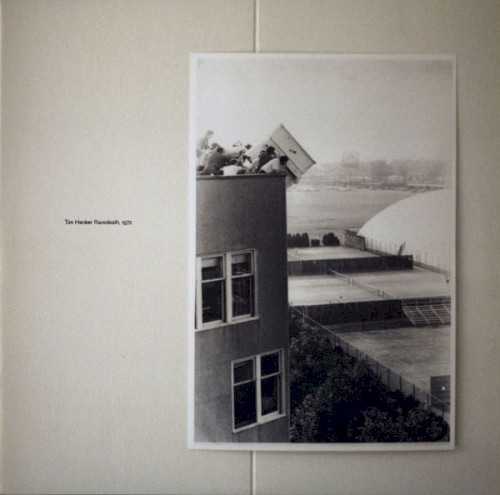 | Album: 12 of 18 Title: Ravedeath, 1972 Released: 2011-01 Tracks: 12 Duration: 52:23 Scroll: Up Down Top Bottom 25% 50% 75% Spotify Allmusic AlbumCover | 1 The Piano Drop (02:53) 2 In the Fog: I (04:52) 3 In the Fog: II (06:01) 4 In the Fog: III (05:00) 5 No Drums (03:24) 6 Hatred of Music: I (06:11) 1 Hatred of Music: II (04:22) 2 Analog Paralysis, 1978 (03:51) 3 Studio Suicide, 1980 (03:24) 4 In the Air: I (04:11) 5 In the Air: II (04:07) 6 In the Air: III (04:01) |
| Ravedeath, 1972 : Allmusic album Review : A title like Ravedeath, 1972 is great because of all the possible associations it calls up. A time-traveling techno explosion, a John Brunner novel title, a 1960s Frug winding down in a horrible dry gulch? Whatever all the possible associations, when Tim Hecker begins the album with the at-once shuddering feedback glitch and distant soothing bliss of "The Piano Drop," the Canadian composer does seem to thrive in an intersection of possibilities from multiple sources. If the principle of plundering the past to create the future is well established, Hecker engagingly demonstrates how the many possibilities it offers remains open. Split into three multi-part pieces and several stand-alone compositions -- some with titles continuing the titular approach, such as "Analog Paralysis, 1978" -- the overall effect of Ravedeath, 1972 is a balance between sheer sonic wooziness and a focused sense of construction; nothing seems wholly random in each songs development even as the feeling can be increasingly disorienting. Of the multi-part pieces, the first, "In the Fog," lives up to the name -- instead of enveloping obscurity, however, its more like a serene float in darkness, with the organ tone loop running throughout the second and third parts providing a bed that whirs and arcing grinds rise and fall on, an underscoring of violence that melds and contrasts with the otherwise calm progression. The concluding "In the Air" almost inverts this, with the feedback tones and growls stabbing out more directly in the first part while the second increasingly brings in the otherwise half-sensed piano. "Hatred of Music," meanwhile, doesnt sound like a radical change from the other parts in terms of overall feel or in matching with the titles sentiment, but the low rhythmic rumble of the second part, a steady progression punctuated by soft piano additions and what sounds like a howling, looming threat in the distance, is pure atmosphere at its best. Then theres "No Drums," which finds in its own calm way the kind of beautiful, dark-toned ambience that has informed the best work in the field of disturbing but never aggressive electronic music. | ||
 | Album: 13 of 18 Title: Dropped Pianos Released: 2011-10-10 Tracks: 9 Duration: 32:25 Scroll: Up Down Top Bottom 25% 50% 75% Spotify AlbumCover | 1 Sketch 1 (07:09) 2 Sketch 2 (03:57) 3 Sketch 3 (01:20) 4 Sketch 4 (02:56) 5 Sketch 5 (04:58) 6 Sketch 6 (01:24) 7 Sketch 7 (03:26) 8 Sketch 8 (01:43) 9 Sketch 9 (05:32) |
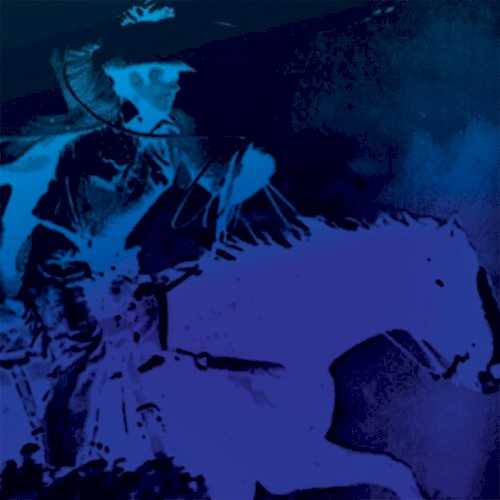 | Album: 14 of 18 Title: Instrumental Tourist Released: 2012-11-20 Tracks: 12 Duration: 54:34 Scroll: Up Down Top Bottom 25% 50% 75% Spotify Allmusic AlbumCover | 1 Uptown Psychedelia (05:58) 2 Scene From a French Zoo (04:59) 3 Vaccination (For Thomas Mann) (05:52) 4 Intrusions (04:52) 5 Whole Earth Tascam (05:00) 6 GRM Blue I (00:50) 7 GRM Blue II (05:48) 8 Racist Drone (05:39) 9 Grey Geisha (04:17) 10 Instrumental Tourist (03:19) 11 Ritual for Consumption (04:44) 12 Vaccination No. 2 (03:12) |
| Instrumental Tourist : Allmusic album Review : The first volume of SSTUDIOS, a series of collaborative releases released on Daniel Lopatins Software imprint, Instrumental Tourist pairs Lopatin with Tim Hecker, another artist who excels at drone-based electronic music, on a set of largely improvised songs. Most of the album doesnt feel like a meeting of the minds so much as a melding of them. Its difficult, in the best possible way, to tell which artist contributed which elements to any given track; one could make a guess about the glitches and torqued string melody on a piece like "Uptown Psychedelia," but the way Hecker and Lopatin combine their styles into a versatile mix of melody, drone, and distortion on "Ritual for Consumption" and the title track is too seamless to dissect. Along with their commitment to improvisation, on Instrumental Tourist they also explore the possibilities of seemingly hokey/patronizing "ethnic" instrument presets, including the koto, sitar, and lap steel, to transcend their intended uses, but first they send them up: "Racist Drone," with its faux shakuhachi flutes and koto and glistening ambience, could very well be some soothing, Eastern-inspired new age music if the song werent interrupted by oddly tweaked percussion and synths whenever it seems close to attaining artificial Zen. "Grey Geisha" follows suit, albeit with more of the ominous undercurrent felt throughout the rest of the album; while these tracks are clever, Hecker and Lopatins more abstract takes on these concepts are among Instrumental Tourists standouts. The title "Intrusions" hints at the albums questioning of "exoticism" and cultural appropriation, but its mix of glitched electronics and penetrating drones that get pinched into shrill spikes stands on its own. "Scenes from a French Zoo" and the Angelo Badalamenti-esque "Vaccination (For Thomas Mann)" let the drones that guide much of the pairs work settle around listeners like a beautifully gloomy fog; what they lack in immediacy, they more than make up for in lasting impact. On these songs, Lopatin and Hecker take the sounds in their intentionally limited palette to places they may never have been expected to go, and the journey is intriguing and frequently lovely. That Instrumental Tourists music was recorded in three days makes it all the more impressive, and bodes well for the rest of the SSTUDIOS albums. | ||
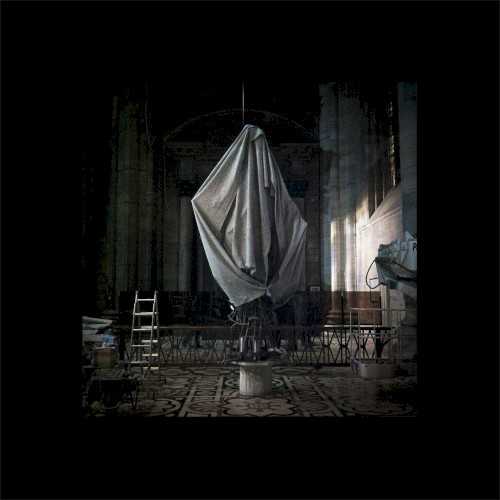 | Album: 15 of 18 Title: Virgins Released: 2013-10-14 Tracks: 12 Duration: 48:52 Scroll: Up Down Top Bottom 25% 50% 75% Spotify TrackSamples Allmusic AlbumCover | 1 Prism (02:53) 2 Virginal I (06:16) 3 Radiance (03:22) 4 Live Room (07:01) 5 Live Room Out (02:37) 6 Virginal II (05:23) 7 Black Refraction (03:33) 8 Incense at Abu Ghraib (01:53) 9 Amps, Drugs, Harmonium (03:03) 10 Stigmata I (02:18) 11 Stigmata II (03:56) 12 Stab Variation (06:30) |
| Virgins : Allmusic album Review : Over six previous albums, Tim Heckers ever-evolving textural and sonic palettes have been rivaled only by his compositional one. His use of acoustic instruments, synths, natural sounds, space, ambience, distortion, feedback, and a structured sense of intimacy, are juxtaposed against the unexpected. Filtered through dynamic editing processes, they alternately present the seductively serene as well as explosively turbulent. Virgins follows his three previous Kranky albums, 2006s Harmony in Ultraviolet, 2008s Imaginary Country, and 2011s Ravedeath, 1972, but markedly departs from them in consciously engaging more musical strategies (like minimalism) without formally employing them. For the first time, Hecker used live ensembles and mixed the sessions with composer Valgeir Sigurðsson. Chamber instruments, flutes, bass clarinets and other woodwinds, piano, and the "virginal," an early harpsichord that can play only a single note a time (and is therefore more percussive than either its cousin or the piano) are placed alongside, and often over, electronic sounds. The virginal plays as central a role as the piano -- check the nearly regal "Live Room," as the instruments attributes are used sequentially and melodically before giving way to sonic disruptions of carefully constructed "noise." "Virginal I" uses multi-layered lines from the instrument, striating them incrementally, creating anxiousness in the listener. "Radiance" and "Black Refraction" offer differing sides of the beatific, as Heckers use of the edit function allows for the unfolding of blurry abstraction of "clean" sound, with an economic use of pulse to interrupt the ecstatic drones and washes. The brief "Incense at Abu Ghraib" employs high, then siren-like pitched strings, and a pumped piano pedal that takes on so much echo it infers the sound of cavernous footsteps; it creates a sense of paranoia before giving way to "Amps Drugs, Harmonium," a less taut successor. It peels back the intrusive atmosphere to allow a more open flow, even inviting a jazzy pianistic invention. The set moves directly into hallucinatory shadow and darkness with the two-part "Stigmata Variation" before it all comes undone in the appropriately titled "Stab Variation." Here motion -- imposed, fractious, distorted -- and a minimal theme played on synths and virtual strings build to the breaking point before slowly dissolving into a sinister, breathing drone. Heckers sound signature may still be instantly recognizable, but there is no denying that he has moved significantly farther down the path with Virgins. | ||
 | Album: 16 of 18 Title: Love Streams Released: 2016-04-08 Tracks: 11 Duration: 42:49 Scroll: Up Down Top Bottom 25% 50% 75% Spotify TrackSamples Allmusic AlbumCover | 1 Obsidian Counterpoint (04:55) 2 Music of the Air (04:08) 3 Bijie Dream (02:16) 4 Live Leak Instrumental (02:56) 5 Violet Monumental I (04:58) 6 Violet Monumental II (03:13) 1 Up Red Bull Creek (02:41) 2 Castrati Stack (04:01) 3 Voice Crack (03:14) 4 Collapse Sonata (04:12) 5 Black Phase (06:15) |
| Love Streams : Allmusic album Review : Canadian experimental ambient artist Tim Hecker made his debut on the legendary 4AD label with one of his most ambitious works yet, 2016s Love Streams. The album includes vocals by the Icelandic Choir Ensemble with arrangements scored by Jóhann Jóhannsson, who released two albums on 4AD during the 2000s. With the exception of the occasional remix, Hecker has never incorporated vocals into his work prior to this album, and he deconstructs the human voice in a similar manner to the way he manipulates acoustic instruments. He encouraged the vocalists to make bizarre sounds in a nonsensical language, and the voices are sometimes fed through Auto-Tune, further twisting and exaggerating them. The idea of processing liturgical choirs through 21st century pop and hip-hop aesthetics seems like it could be a disastrous novelty, but it makes perfect sense within Heckers landscape of granulated electronics. On tracks such as "Bijie Dream," the synthesizer melodies seem to thrash around as if theyre stuck in sand, never sticking to a steady rhythm, but urgently pushing and fighting their way through. The vocals seem to behave this way at times, erupting in tonal clusters and mutating into strange, garbled noises that approximate Heckers fuzzy textures and static bursts. While some of Heckers work can be harsh and bleak (at least in the realm of ambient music), Love Streams is one of his most vibrant, melodic works. In addition to vocals, theres a heavy presence of woodwinds on the album, as well as what sounds like steel pan drums. Both of these elements add rich tonal colors as well as softly throbbing rhythms to the music, particularly on pieces like "Violet Monumental II." There are still a few alarming moments of disruptive noise, such as the beginning of the stunning "Castrati Stack," but theyre smoothed out by the rippling melodies and heavenly vocals. Love Streams is easily Heckers most accessible work to date, yet its also one of his most challenging, as it finds him pushing his sound into new directions while he explores the possibilities of the human voice. | ||
 | Album: 17 of 18 Title: Konoyo Released: 2018-09-28 Tracks: 7 Duration: 00:00 Scroll: Up Down Top Bottom 25% 50% 75% Spotify TrackSamples Allmusic AlbumCover | 1 THIS LIFE (?) 2 IN DEATH VALLEY (?) 3 IS A ROSE PETAL OF THE DYING CRIMSON LIGHT (?) 4 KEYED OUT (?) 5 IN EARTH MOTHER PHASE (?) 6 A SODIUM CODEC HAZE (?) 7 ACROSS TO ANOYO (?) |
| Konoyo : Allmusic album Review : Tim Hecker recorded most of Konoyo in Japan, working with members of the gagaku ensemble Tokyo Gakuso, who play a variety of traditional wind and percussion instruments. Heckers previous album, Love Streams, featured vocals by an Icelandic choir, who sang in a nonsensical language and were twisted into bizarre, alien forms. Hecker does similar business with the gagaku ensemble on Konoyo, sometimes rendering the source material nearly unrecognizable, letting it seep through the mix in subtle ways. The album is informed by ideas of negative space, and theres certainly more of a sense of restraint here compared to other Hecker releases, and not as much charred feedback. That said, theres still an enormous amount of detail to these highly immersive sonic constructions. Opening with distressed siren-like tones which slowly swoop down, "This Life" features woozy clusters of notes which bring to mind Arcas melodies, with frayed distortion bubbling up and swerving around, as well as a tangible sense of things being physically pushed and pulled. The acoustic instruments are much clearer on "In Death Valley," which has delicately plucked strings and knocking drums joined by the sideways thud of Heckers scattered, crystalline synths. Tracks such as "Keyed Out" are punctuated with high-frequency whistling from instruments such as the ryuteki and the shō. These tones can seem disarming at first, but they contribute to the urgency of the music, in addition to feeling like glimpses into a distant past. Konoyo takes several listens to fully appreciate, as do most Hecker releases, but its another excellent example of the distinct mixture of bleakness and majesty which he excels at creating. | ||
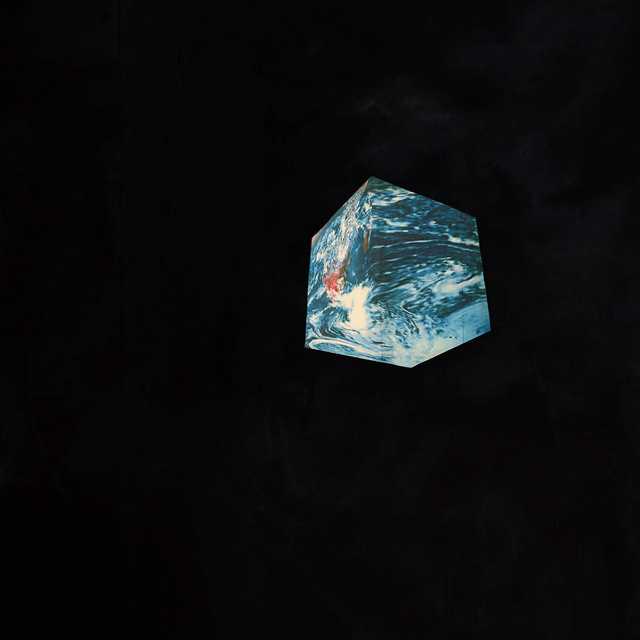 | Album: 18 of 18 Title: Anoyo Released: 2019-05-10 Tracks: 6 Duration: 34:26 Scroll: Up Down Top Bottom 25% 50% 75% Spotify Allmusic AlbumCover | 1 That World (09:10) 2 Is but a Simulated Blur (04:10) 3 Step Away From Konoyo (04:38) 4 Into the Void (04:48) 5 Not Alone (03:10) 6 You Never Were (08:30) |